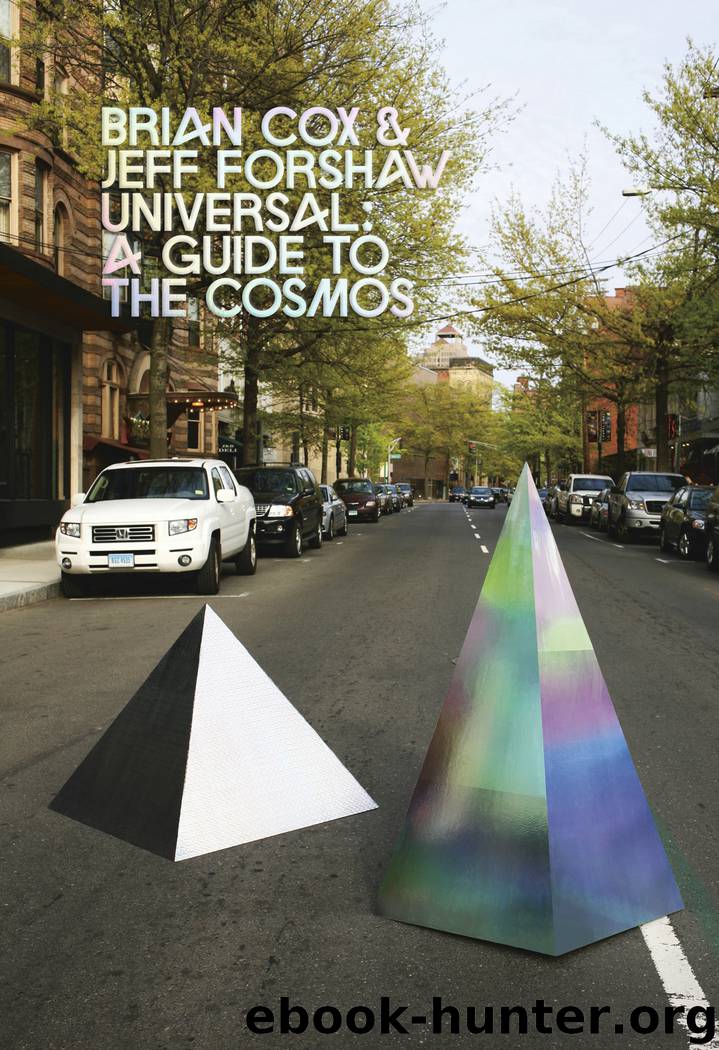Universal by Brian Cox

Author:Brian Cox
Language: eng
Format: azw3, epub
ISBN: 9780141968346
Publisher: Penguin Books Ltd
Published: 2020-06-05T22:56:35.453151+00:00
Figure 6.5
The origin of the Cosmic Microwave Background (CMB) radiation.
Dicke and his colleagues made these observations having just heard the news that, away at the Bell Laboratories in New Jersey, Arno Penzias and Robert Wilson had detected an unexpected background of microwaves through a telescope. The fact that the photons from the Cosmic Microwave Background (CMB) should today be observed as microwaves is exactly as expected, because the expansion of space since the time of recombination redshifted the photons to microwave wavelengths. By the mid-1960s, the evidence for what is now known as the CMB had become compelling. The Earth, in other words, is bathed in microwave radiation of precisely the kind anticipated if the Universe had indeed passed through a hot phase before the formation of atoms.
Interestingly enough, the idea that the Universe should today be filled with CMB radiation goes back decades before Penzias and Wilson’s Nobel Prize-winning discovery. In 1948, in a tremendous burst of creativity, George Gamow, Ralph Alpher, Robert Herman and Hans Bethe wrote a series of eleven research papers in which they developed the theory of Big Bang Nucleosynthesis.11 Gamow and colleagues’ ideas were ahead of their time and lay largely dormant until the discovery of the CMB in 1964.
The CMB and its properties have been, and continue to be, examined in detail. This oldest light is a treasure trove of information, because it provides earth-bound astronomers with an opportunity to garner information on what happened shortly after the Big Bang. We’ll be delving much further into the treasures of the CMB in Chapter 8, but for now we are going to focus on the broad features of those old, stretched photons from the beginning of time, which we now detect on Earth as microwaves.
Figure 6.6 shows a measurement of the CMB made in the early 1990s by the Cosmic Background Explorer (COBE) satellite. It shows how the microwaves arriving at the Earth are distributed in wavelength. The height of the curve measures the brightness of the microwaves and the shape tells us how this is distributed across different wavelengths. We see that the most commonly occurring wavelength is around 2 mm. What is clear from the graph is that the measured data points are in perfect agreement with the theoretical expectation, which is the smooth solid line.
That smooth line is the result of a calculation originally performed in the late nineteenth century by Max Planck, the brilliant German physicist who also played a central role in the early development of quantum physics. It is the curve corresponding to the spectrum of light emitted by an object cooled to a temperature of 2.73 kelvin, which is just over minus 270 degrees celsius. This amazing agreement between Max Planck’s calculation and the COBE measurements is what Dicke and colleagues anticipated when they spoke of ‘black-body radiation’. Here, the technical term ‘black-body’ is used to describe how the energy of a gas is shared out between its component particles when all parts of the gas are at the same temperature.
Download
This site does not store any files on its server. We only index and link to content provided by other sites. Please contact the content providers to delete copyright contents if any and email us, we'll remove relevant links or contents immediately.
| Aeronautics & Astronautics | Astronomy |
| Astrophysics & Space Science | Comets, Meteors & Asteroids |
| Cosmology | Mars |
| Solar System | Star-Gazing |
| Telescopes | UFOs |
Turbulence by E. J. Noyes(7032)
Tools of Titans by Timothy Ferriss(6936)
Astrophysics for People in a Hurry by Neil DeGrasse Tyson(4614)
Room 212 by Kate Stewart(4099)
Pale Blue Dot by Carl Sagan(3996)
The David Icke Guide to the Global Conspiracy (and how to end it) by David Icke(3875)
Secrets of Antigravity Propulsion: Tesla, UFOs, and Classified Aerospace Technology by Ph.D. Paul A. Laviolette(3432)
Apollo 8 by Jeffrey Kluger(3196)
Losing the Nobel Prize by Brian Keating(3184)
A Journey Through Divination and Astronomy by Publishing Pottermore(3029)
Goodbye Paradise(2949)
COSMOS by Carl Sagan(2944)
Brief Answers to the Big Questions by Stephen Hawking(2873)
How to Read Water: Clues and Patterns from Puddles to the Sea (Natural Navigation) by Tristan Gooley(2849)
The Five People You Meet in Heaven by Mitch Albom(2834)
The Order of Time by Carlo Rovelli(2708)
How to Read Nature by Tristan Gooley(2657)
A Brief History of Time by Stephen Hawking(2471)
Aliens by Jim Al-Khalili(2376)
